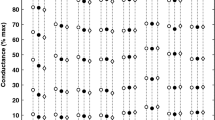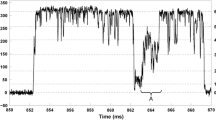Abstract
(1) Analysis of the durations of open and shut intervals measured from single channel currents provides a means to investigate the mechanisms of channel gating. Durations of open and shut intervals are conveniently measured from single channel data by using a threshold level to indicate transitions between open and shut states. This paper presents a detailed characterization of sampling, binning, and noise errors associated with 50% threshold analysis, provides criteria to reduce these errors, methods to correct for them, and presents an efficient means of data handling for binning and plotting interval durations. (2) Measuring interval durations by sampling at a fixed rate introduces two types of errors, (a) the number of intervals of a given measured duration are increased (promoted) over that expected in the absence of sampling, producing a sampling promotion error, (b) sampling decreases the total fraction of true intervals that are detected, producing a sampling detection error. Sampling errors can be reduced to negligible levels if the actual or effective (after interpolation) sampling period is less than 10–20% of both the dead time and fastest time constant in the distribution of intervals. Dead time is given by the duration of a true interval that has a filtered amplitude equal to 50% of the true amplitude. (3) Methods are presented to correct for sampling promotion error during least squares and maximum likelihood fitting. Sampling detection error is more difficult to correct, but an empirical description of the sampling detection error can be used to calculate the effective fraction of detected events with sampling. (4) Noise in the single channel current record can produce two types of error. (a) If noise peaks in the absence of channel activity exceed the threshold for detection, then false channel events of brief duration are produced. Sufficient filtering will prevent this type of error. (b) Noise can also increase the total fraction of true intervals that are detected, producing a noise detection error. Increased filtering over that required to prevent false events is not necessarily the best method for reducing noise detection error, as increased filtering can prevent detection of the faster exponential components. (5) Noise detection error can be reduced in two ways: (a) an empirical description of the noise detection error can be used to calculate the effective fraction of detected events in the presence of noise. (b) The sampling period can be selected so that the sampling detection error cancels the noise detection error. (6) Combining (binning) intervals with a range of durations into single bins promotes the amplitudes of the bins, producing a binning promotion error similar to the sampling promotion error, but of smaller magnitude. Binning promotion error can be avoided if bin width is less than 20–30% of the fastest time constant. Methods are presented to correct for binning promotion error for interval durations measured with continuous time resolution or by sampling. (7) Storing and plotting intervals from single channels is often difficult because interval durations and frequency of occurrence can range over many orders of magnitude. Binning intervals based on the logarithms of their durations provides a convenient method to overcome these difficulties, as several hundred bins are sufficient to bin any number of intervals of any expected duration with essentially no errors associated with fitting and plotting the distributions of intervals. Log binning can reduce the time required to fit the data by orders of magnitude for large numbers of events, and log binning provides increasing bin widths as interval durations increase to combine the necessary number of intervals for plotting of data without excessive fluctuation. (8) Plotting distributions of intervals on log-log plots is an effective way to present distributions of intervals that span orders of magnitude in frequency of occurrence and duration. Each bump in the distributions on log-log plots indicates an exponential component. (9) Using the techniques described above for efficient data handling and for the prevention or reduction of errors associated with sampling, binning, and noise, true rate constants and expected distributions of intervals were determined from sampled, log binning, filtered, and noisy data with errors of typically less than 1–2% for two and four state models.
Similar content being viewed by others
References
Anderson CR, Stevens CF (1973) Voltage clamp analysis of acetylcholine produced end-plate current fluctuations at frog neuromuscular junction. J Physiol (Lond) 235:655–691
Barrett JN, Magleby KL, Pallotta BS (1982) Properties of single calcium-activated potassium channels in cultured rat muscle. J Physiol (Lond) 331:211–230
Blatz AL, Magleby KL (1986a) Correcting single channel data for missed events. Biophys J 49:967–980
Blatz AL, Magleby KL (1986b) Quantitative description of three modes of activity of fast chloride channels from rat skeletal muscle. J Physiol (Lond) 378:141–174
Colquhoun D (1971) Lectures on biostatistics: An introduction to statistics with applications in biology and medicine. Oxford University Press, London
Colquhoun D, Hawkes AG (1981) On the stochastic properties of single ion channels. Proc R Soc Lond [Biol] 211:205–235
Colquhoun D, Hawkes AG (1982) On the stochastic properties of burts of single ion channel openings and of clusters of bursts. Proc R Soc Lond [Biol] 300:1–59
Colquhoun D, Sakmann B (1981) Fluctuations in the microsecond time range of the current through single acetylcholine receptor ion channels. Nature 294:464–466
Colquhoun D, Sigworth FJ (1983) Fitting and statistical analysis of single-channel records. In: Sakmann B, Neher E (eds) Single-channel recording. Plenum Press, New York, pp 191–263
Hamill OP, Marty A, Neher E, Sakmann B, Sigworth FJ (1981) Improved patch-clamp techniques for high-resolution current recording from cells and cell-free membrane patches. Pflügers Arch 391:85–100
Horn R, Lange K (1983) Estimating kinetic constants from single channel data. Biophys J 43:207–223
Kerry CJ, Kits KS, Ramsey RL, Sansom MSP, Usherwood PNR (1986) Single channel kinetics of a glutamate receptor. Biophys J 50:367–374
Magleby KL, Pallotta BS (1983) Calcium dependence of open and shut interva' distributions from calcium-activated potassium channels in cultured rat muscle. J Physiol (Lond) 344:585–604
Miller C (1983) Integral membrane channels: Studies in model membranes. Physiol Rev 63:1209–1242
Rao CR (1973) Linear statistical inference and its applications. John Wiley, New York
Roux B, Sauve R (1985) A general solution to the time interval omission problem applied to single channel analysis. Biophys J 48:149–158
Sachs F, Neil J, Barkakati N (1982) Instruments and techniques: The automated analysis of data from single ionic channels. Pflügers Arch 395:331–340
Sakmann B, Patlak J, Neher E (1980) Single acetylcholine-activated channels show burst-kinetics in presence of desensitizing concentrations of agonist. Nature 286:71–73
Sine SM, Steinbach JH (1986) Activation of acetylcholine receptors on clonal mammalian BC3H-1 cells by low concentrations of agonist. J Physiol (Lond) 373:129–162
Wilson DL, Brown AM (1985) Effect of limited interval resolution on single channel measurements with application to Ca channels. IEEE Trans Biomed Eng 32:786–797
Author information
Authors and Affiliations
Rights and permissions
About this article
Cite this article
McManus, O.B., Blatz, A.L. & Magleby, K.L. Sampling, log binning, fitting, and plotting durations of open and shut intervals from single channels and the effects of noise. Pflugers Arch. 410, 530–553 (1987). https://doi.org/10.1007/BF00586537
Received:
Revised:
Accepted:
Published:
Issue Date:
DOI: https://doi.org/10.1007/BF00586537




